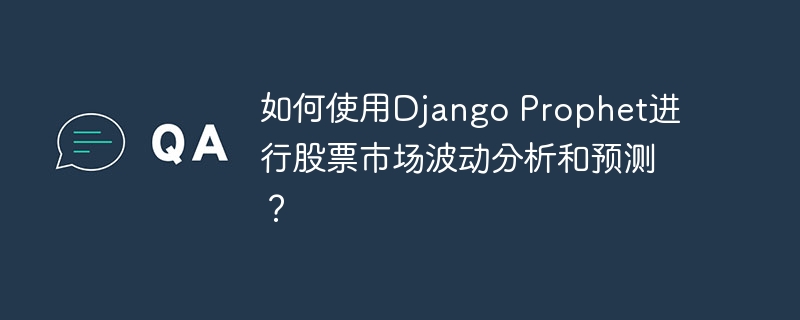Home >Backend Development >Python Tutorial >How to use Django Prophet for stock market fluctuation analysis and prediction?
How to use Django Prophet for stock market fluctuation analysis and prediction?
- 王林Original
- 2023-09-27 15:57:091416browse

How to use Django Prophet for stock market fluctuation analysis and prediction?
Introduction:
With the rapid development of the Internet and financial technology, the stock market has become the focus of all types of investors. The analysis and prediction of stock market fluctuations are of great significance to investors' decision-making. This article will introduce how to use the Django Prophet library for stock market fluctuation analysis and prediction to help investors make more accurate decisions.
1. What is Prophet?
Prophet is Facebook's open source time series forecasting library in 2017. It is easy to use, accurate and reliable, and can handle time series data with trends, seasonality and outliers. The Prophet model uses a statistical method called Additive Decomposition Model. In Prophet, you can use historical data to predict trends, seasonality, and outliers, and analyze and predict stock market fluctuations based on these prediction results.
2. Steps to use Django Prophet to analyze and predict stock market fluctuations
-
Install the Django Prophet library
First, you need to install the Django Prophet library in the Django project . It can be installed through the following command:pip install django-prophet
After the installation is complete, add the Django Prophet library to the INSTALLED_APPS configuration of the Django project.
- Collect historical data of the stock market
Before conducting analysis and prediction of stock market fluctuations, it is necessary to collect historical data of the stock market. Historical data can be obtained from various financial data providers, stock exchanges or financial websites and stored in the database. - Create Django Prophet model
In the Django project, create a Django Prophet model. You can define a model class that inherits from BaseModel in Django Prophet in the models.py file. In the model class, you can define historical data fields of the stock market and some methods related to fluctuation analysis and prediction.
The sample code is as follows:
from django.db import models
from django_prophet.models import BaseModel
class Stock(models.Model):
date = models.DateField()
price = models.FloatField()
class StockProphet(BaseModel):
class Meta:
db_table = 'stock_prophet'
stock = models.ForeignKey('Stock', on_delete=models.CASCADE)
def fit_model(self):
self.model.fit(self.get_dataset()) # 使用Prophet模型进行拟合
def predict(self, periods=30):
future = self.model.make_future_dataframe(periods=periods)
forecast = self.model.predict(future) # 预测
return forecast
def plot(self, forecast):
self.model.plot(forecast) # 绘制波动分析图
def save_results(self, forecast):
forecast.to_csv('forecast_results.csv') # 保存预测结果到CSV文件- Use Django Prophet for fluctuation analysis and prediction
In the view function or Django command, you can call the Django Prophet model defined above Methods in this class perform fluctuation analysis and prediction.
The sample code is as follows:
from django.http import HttpResponse
from .models import StockProphet
def analyze_stock(request):
stock_prophet = StockProphet.objects.first()
stock_prophet.fit_model()
forecast = stock_prophet.predict()
stock_prophet.plot(forecast)
stock_prophet.save_results(forecast)
return HttpResponse("分析和预测已完成!")3. Summary
This article introduces how to use Django Prophet to analyze and predict stock market fluctuations. By using the Django Prophet library, we can easily analyze and predict stock market fluctuations and improve investors' decision-making capabilities. Of course, different stock markets have their own characteristics and laws. When investors use this method to analyze and predict fluctuations, they need to make reasonable adjustments and judgments based on the actual situation.
The above is the detailed content of How to use Django Prophet for stock market fluctuation analysis and prediction?. For more information, please follow other related articles on the PHP Chinese website!
Related articles
See more- Introduction to how Django uses Social-Auth to implement QR code login on WeChat third-party websites
- How to prevent the form page in Django from automatically submitting after refreshing
- Implementation steps of Django's library management system (with code)
- What is ThreadLocal? Principle analysis of ThreadLocal
- Configuration and use of mongodb for django development

